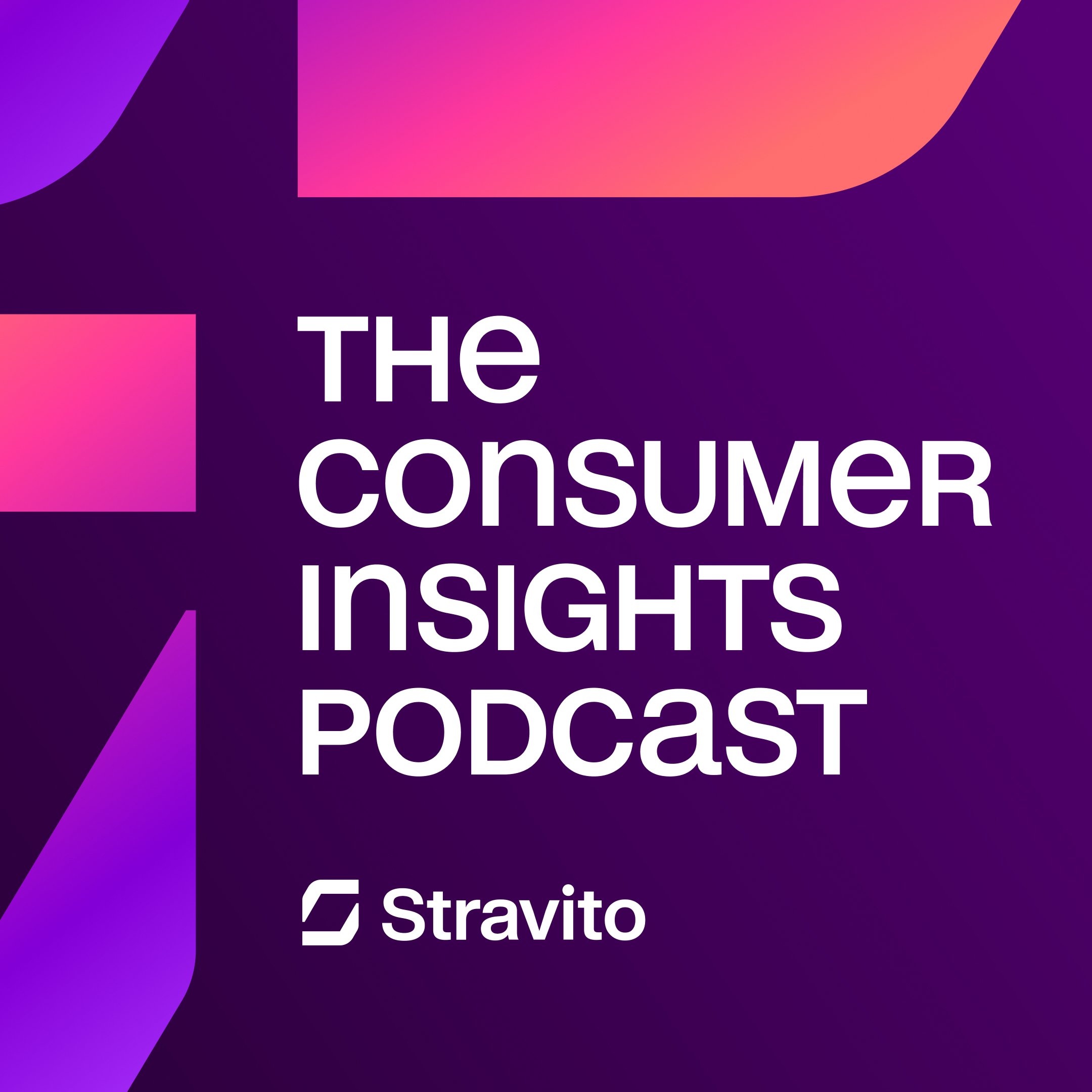People, Data and Insights: Connecting the Dots
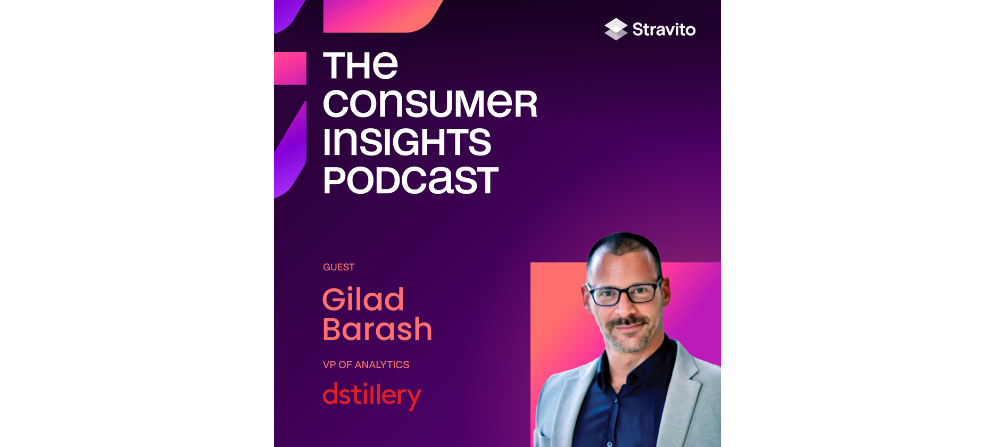
In this episode of The Consumer Insights Podcast, we speak with Gilad Barash, VP of Analytics at Dstillery.
- Leveraging measurable market research to put insights in context
- How eye tracking provides real-time insights
- The importance of integrating market research methodologies
- What eye tracking can tell you that other research methods can’t
- Reasons that companies miss out on valuable insight generation
- Why diversity is so important for insights teams
- Essential tools for an insight professional
- Tips on how insights professionals can be more effective
If you’re interested in how effective market research can lead to valuable and applicable consumer insights, tune into this episode of The Consumer Insights Podcast.
You can access all episodes of the Consumer Insights Podcast on Apple, Spotify, Google, or use the RSS feed with your favorite player. Below, you'll find a lightly edited transcript of this episode.
Thor Olof Philogène: Hello, everyone, and welcome to this episode of The Consumer Insights Podcast. Today I'm super excited to have a brilliant insights leader joining me for what I know will be a fantastic conversation.
Gilad Barash is the VP of Analytics at Dstillery, which provides companies with custom audience solutions. He also has more than three decades of research experience and data handling and is the host of the Who's Your Data Podcast. Thank you so much for joining me, Gilad.
Gilad Barash: Thanks for having me. I'm very excited to be here.
Thor: Firstly, could you take a couple of minutes to tell us about yourself, your company, and how you got to where you are today? How did it start?
Gilad: Absolutely. I've been working at Dstillery for about nine years now. VP of analytics to companies that provide audiences, digital audiences, for marketers, for market research across a variety of industries.
I got here sort of by chance. I started out in the Israeli army, working in software there, and then found my way to San Diego, California where I went to school, and I did my Bachelor's and Master's in Computer Science and then continued through working at HP doing operations research.
I finally found my way to a fashion tech startup in New York City that didn't last very long and then found my way to Dstillery. I always went with what felt right at the moment and the interesting problems and opportunities that just happened to come across my way.
Defining insights and their relationship with data
Thor: One question that I typically like to ask guests on the podcast is how they define an insight but I want to put a bit of a twist on, given your areas of expertise.
The question is, how do you define an insight, and also, how would you describe the relationship between insights and data?
Gilad: That's a very good question. I would start with saying, I think that insights are derived from data. Data is the observations that you see, insights is what you do with them, and the conclusions that you arrive at.
To me, an insight is something that is interesting in the data that you may not have known and that affects your decisions on how to move forward.
To me, how I define different people has really different definitions for insights. To me, an insight is something that is interesting in the data that you may not have known and that affects your decisions on how to move forward.
It can also be something that you did know that will strengthen a decision that you've made but if it helps you to strategically decide how to move forward, that to me is an insight.
What makes insights and market research important
Thor: In your view, why are market and consumer insights so important? What does accessing, what does analyzing, what does integrating insights allow businesses to do?
Gilad: At the end of the day, without data, all you have is an opinion. You are shooting in the dark. You are as we call it in the ad tech industry, “You spray and pray”.
You just show ads to people, and you hope that somebody is interested in them. You're wasting your ad dollars, you're wasting a lot of work that is done behind the scenes.
At the end of the day, without data, all you have is an opinion.
And by being able to consolidate and to synthesize new data and derive insights from it, you are able to, first of all, save money in your efforts and really get more bang for your buck when you are targeting people.
Secondly, having more meaningful engagement with your consumers and being able to really push your vision forward for your brand, because you're able to engage with the right people at the right time about the right topic that is interesting to them.
Preparing for the cookie-less future
Thor: Something that you guys at the Dstillery speak a lot about is the cookie-less future. Can you tell us a bit more about that?
Gilad: Yes. This is really a big earthquake in the advertising industry and certainly in the ad tech environment.
Third-party cookies are mechanisms that track where devices and browsers are browsing the internet. They are basically a list of the different websites that people go to. Now it's anonymous and it does not include any PII or personally identifiable information but it has allowed the industry to utilize that tracking in order to understand specifically at the device level, what people are interested in,
What their journey is, what their consumer journey is, how they navigate through the web in their life, what websites they're interested in, what they go back to, etc.
That has really been the pillar of ad tech, especially in the sense of measurement and being able to understand if advertising has been effective. Especially targeted advertising which allows us to personalize that advertising based on knowing information about these anonymous browsers, what they had browsed so we know what they're interested in.
This presents a huge challenge to the industry, about how to know what the consumer is doing, how to know how to engage with them in a meaningful way, and certainly how to measure whether that engagement was effective.
What's happening today is that there is a timeline for when Google will deprecate these third-party cookies and then this whole notion of being able to track and understand what browsers and devices do is going away.
This presents a huge challenge to the industry, about how to know what the consumer is doing, how to know how to engage with them in a meaningful way, and certainly how to measure whether that engagement was effective.
Thor: If you take a look at what you just said, and you apply the lens of the insights teams, what are some of the consequences you foresee with those insights teams?
Gilad: That's an excellent question. One of the major issues that are going to emerge is that part of this tracking and understanding the history of browsers and devices, is that we were also able to derive insights about these consumers based on that information, that's going away as well.
Today, the industry is working hard to find alternatives to using third-party cookies in order to also be able to derive insights.
At Dstillery, we've been working on technology that allows us to do all of that without those third-party cookies as far as modeling, creating audiences, and as well as deriving insights because what we discovered is that ID free does not mean insights free.
We are still able to, and this is something that companies are working on today, find new methodologies to derive insights about the consumers, even without the third party cookie in order to continue to enable meaningful engagement.
Targeting and human centricity
Thor: Targeting is obviously at the core what Dstillery does, and how would you say that targeting fits into human centricity?
Gilad: At the end of the day, the role of targeting is to allow brands to engage with the consumers in ways that are interesting to them, benefit them and allow them to create a connection with that brand that is personal, and provide a lasting loyalty to that brand.
Being able to do that on a personalized basis, being able to engage with them about things that are interesting to them based on their behavior is very important.
When you look at a brand's first-party data, the data that they collect when let's say you're on their website, you are engaging with them directly, that's a very important view.
The role of targeting is to allow brands to engage with the consumers in ways that are interesting to them, benefit them, and allow them to create a connection with that brand that is personal, and provide a lasting loyalty to that brand.
Every brand that has a website or has a CRM list has that view. But, there is a blind spot in what the consumer is doing the other 23 and a half hours of the day when they are not engaging with your brand on your website.
That non-engagement time is where those third-party cookies come in where you can see, you track other websites that they go to, and that gives you insight into their overall behavior, not just when they engage directly with your brand.
What did they buy? How much of it did they buy? How often do they buy? Do they open your emails, et cetera but are they looking at mortgage loans? Are they dog lovers? Are they looking at hair-care products? What else are they doing the rest of the time?
Being able to understand that and complement your first-party data with that view is very important in order to be able to understand human behavior that you can then engage with.
Fueling innovation through insights
Thor: That's super interesting. Could you maybe give me an example of a time when insights from Dstillery have fueled innovation in a way that has led to say a better campaign, a better project or a better product?
Gilad: Absolutely. We tell data stories, and this is one of the things that is super interesting to me when I always say that our analysts are data storytellers. It is just as much an art as it is a science.
To tell the story, to a) curate the data in a way that has a compelling story, and b) also to represent it in a way that is compelling. One of the things that I always say is when you're showing insights, it's a balancing act.
On one hand, if you show intuitive insights, the stakeholder will think, "Okay, well, I didn't need you to know, I knew all of this." If you focus on the non-intuitive insights and the surprise insights, you may not get buy-in, and they may have an issue with the confidence in the data, like "None of this makes sense to me."
Data storytelling to stakeholders is really a balancing act of both of those where you want to show a combination of intuitive facts or intuitive insights, as well as non-intuitive ones, which really are where I think the value is, these are insights that allow you to make decisions that you would not have done otherwise.
We found that there was a group of basically Jewish grandmothers that were shopping around for presents for their Bar and Bat Mitzvah grandchildren.
One example that I can give you is we worked with a luxury watch and jewelry company that was interested in understanding its market, its consumers, “Who are they? What are they interested in? What are they trying to do?”
We utilized some of our machine learning algorithms, in this case, we specifically used an unsupervised clustering method to sort of group the different devices together, based on their shared history, and then look at what behaviors were unique to each one of these groups.
There were big subgroups of people who wear luxury watches, and jewelry shoppers, love luxury clothing. They had vacation homes, there were some of these, which are the intuitive insights that you would think of when you think of luxury watches.
Then there were also the smaller groups, the data nuggets that we thought were the more interesting ones.
One of the ones that they thought were surprising, and were very interested to learn, we found that there was a group of basically Jewish grandmothers that were shopping around for presents for their Bar and Bat Mitzvah grandchildren.
It was a smaller group, but what's exciting about that is that is basically a growth market, that is a potential growth market for the brand. When we presented this to them, and put that story together, they were very excited about that.
We learned that because we could see in that subgroup that they had a very distinct signal for retirement websites, and AARP and things like that, as well as looking at Bar Mitzvah resources in synagogues, as well as shopping for those luxury watches.
It was a smaller group, but what's exciting about that is that is basically a growth market, that is a potential growth market for the brand. When we presented this to them, and put that story together, they were very excited about that.
Indeed, subsequently created a campaign to target and to engage more with that subgroup of people, which they never would have realized, unless we looked at the data and told these stories.
Tools for insights professionals
Thor: That's a fascinating story. I love how you highlight one of the fundamental challenges of people working with insights of actually completing that balancing act.
If we switch topics slightly and we think more about the essentials to support insights professionals, what tools do you believe are essentials to enable that support to those insights professionals and why?
Gilad: In terms of the skills that insights professionals should have, I'll say the skills that I look for in insight analysts, it ranges from the sort of low-level knowledge of SQL and Python, and perhaps R, but you have to know how to get to the data, and to do something with it. That sort of table thing.
Then from a higher level, it's curiosity, and I want to call it intuition about data. When you look at something, you look at a table with numbers, you need to be able to feel that something might be off, something looks like it's an error, maybe there are anomalies, you should have a curiosity and a lack of confidence to question what you're looking at.
Those are skills that I feel are very important for analysts that I look for.
Why data science is about people
Thor: Then in your LinkedIn bio, building a bit on that you stated “that data science is not about data. It's about people.” Maybe you could describe the relationship between data and people, and tell us a little more what you mean there.
Gilad: What I mean by that, is that at the end of the day, data science is more than just being about numbers, it affects people, it affects life.
When you're making decisions, when you're telling data stories, you are affecting people's lives. Whether it be through advertising, through algorithms that decide to score you for loans, wherever it might be, at the end of the day these algorithms affect people.
By the way, part of the premise of my own podcast, Who's your data? is how data affects life and how life affects data? We're surrounded by data, we create data every day, we are manipulated by data every day, and so how does that affect our lives in all the different ways?
At the end of the day, when you're making decisions, when you're telling data stories, you are affecting people's lives. Whether it be through advertising, through algorithms that decide to score you for loans, wherever it might be, at the end of the day these algorithms affect people.
The DNA of a successful insights team
Thor: I really liked that, and I might even quote you on that one. You've written quite eloquently on the importance of diversity of equality and inclusion. How would you say that those fit into the DNA of a successful insights team, or for any team for that matter?
Gilad: I think that they are crucial to the success of an insights team, or any team, even a product or engineering team.
I think it's true for all industries, definitely the one that I've been exposed to in tech, I think it is crucial, because what you need in order to be successful is a diversity of opinions, and backgrounds and perspectives.
If you have a homogeneous team, the perspective and the goal and the methodology that the product or the algorithm uses are going to be homogeneous, and you will miss out. There are several examples of that.
I can say, when our industry, for example, we came across issues where audiences can get created that you're not thinking about them in a more inclusive way, and they may end up being, first of all, offensive to some people., they may just miss the target, and you're not actually getting to the people that you want to, and you won't be successful, or it will be a lot harder to be successful.
What you need in order to be successful is a diversity of opinions, and backgrounds and perspectives.
If you have a homogeneous team, the perspective and the goal and the methodology that the product or the algorithm uses are going to be homogeneous, and you will miss out.
Whether it be algorithms that when we work with data, especially in data science, there's a lot of inherent bias in data, the success and the robustness of a data science algorithm that you create, the results of the model are inherently tied to the quality of the data that you provide it. If the data is biased, the results in the model will be biased.
One of the great examples that I remember from this when I was researching it, I was talking to a friend of mine who's a fashion designer. He's a Nigerian fashion designer, and he was telling me how he was involved in creating software that would identify the designers and the styles from image recognition.
Because it was only fed American designers, which were predominantly white, it would not identify African styles and African designers. That was a bias in the data that if you don't have a diverse team of people with diverse opinions and backgrounds and perspectives, working on these products, you will miss things, and it will be to the detriment of your product.
It makes business sense to make sure that you have a diversity of perspectives on any team that you're working with.
How to elevate insights with organizations
Thor: I think you make a very strong solid point there and it is true that if you are not aware of it, actually the diversity is also impacted by the data you bring to the table, so I fully agree with that, I think it is a super solid point.
What skills do you believe that are essential to elevate insights within organizations? What is it that is required?
Gilad: That's an interesting question. I think first of all, table stakes are having the ability to access the data, and to tell great stories with it. The other part of that, though, is more along the soft skills of how you propagate the insights, how you disseminate the information, and how you even convince different teams, the stakeholders.
Whether it be through interesting visualizations, whether it be through dashboards that are at their fingertips, there's an element of selling your product of insights to the larger organization.
First of all, convince them that they are stakeholders and that they would benefit from these analyses, and then how they adopt them. Whether it be through interesting visualizations, whether it be through dashboards that are at their fingertips, there's an element of selling your product of insights to the larger organization.
What I find interesting and entertaining is that an insights team also does a little bit of product management, does a little bit of user requirements testing, in order to be able to create the product that is the insights machine and then sell it to the stakeholders.
How insights professionals can challenge the status quo
Thor: You've obviously touched on it slightly but when you look at opportunities that exist for insights professionals to make further true business impact. If we focus on impact and challenging the status quo, what other opportunities do you see?
Gilad: Well, first of all, in the industry as we mentioned before, the status quo is going to change because of the deprecation of third-party cookies. I think that ID free does not mean insight free.
There will be new challenges for analysts that we will have to use, methodologies that are not based on third-party cookies for deriving these insights. I think that while this is a challenge, I think it's also an opportunity because there are industries that traditionally were not able to use the ID-based or the third-party cookie-based insights because they relied very heavily on privacy.
Industries such as healthcare and finance that with the deprecation of cookies actually presents an opportunity to delve more into these industries and provide perhaps ID free insights for healthcare providers, pharmaceuticals, different medical conditions, where the assurance privacy and anonymity is much greater because there's just no data collected about the consumers' finances in other industry.
I think that being able to work on problems like that is something that's exciting and is an opportunity to break the status quo. That's certainly something that I'm excited that the Dstillery is working on and see how that changes the status quo in the industry.
Who Gilad would love to have lunch with in the world of insights
Thor: Well, Gilad, it hurts me to know that we are at the end of this conversation. I think we've had such an interesting conversation. There are so many elements that I would have loved spending more time on, but I do have one last question for you. It is a question I love to ask, which is “Who in the world of insights would you love to have lunch with?”
Gilad: I am going to go with the one person that I'm always happy to have lunch with in the insights industry is Kristin Luck, who is the president of ESOMAR. Always interesting conversations with her about the industry and about trends. I would recommend anybody if you see her at any conferences to say hi and to pick her brain.
Summary
Thor: I fully agree. Kristin is an amazing person. I might eavesdrop on that lunch.
Gilad, this has been such an eye-opening conversation and it's really been fantastic to learn from your career experience and to hear how you and how Dstillery are using data science and AI to help companies reach the right audiences.
Playing a couple of things back. Some things that I remembered from our conversation, I think there's the obvious benefit of how insights can help businesses save money and also make money, but I think, more importantly, insights can help them have a more meaningful engagement with the consumer.
I think it's important for us never to forget that when you work with data, the outcome of your work, the outcome of your insights will actually impact people. It will impact humans as you put it so eloquently.
I also really like the reminder for us to curate the data that brings forward the compelling story, and just the reality of how data storytelling is a balancing act between the intuitive and the non-intuitive insights.
Gilad, I know I've learned a lot talking from you today and I'm sure our audience has as well so thank you so much for joining me today.
Gilad: Thank you so much for having me.
Related Content
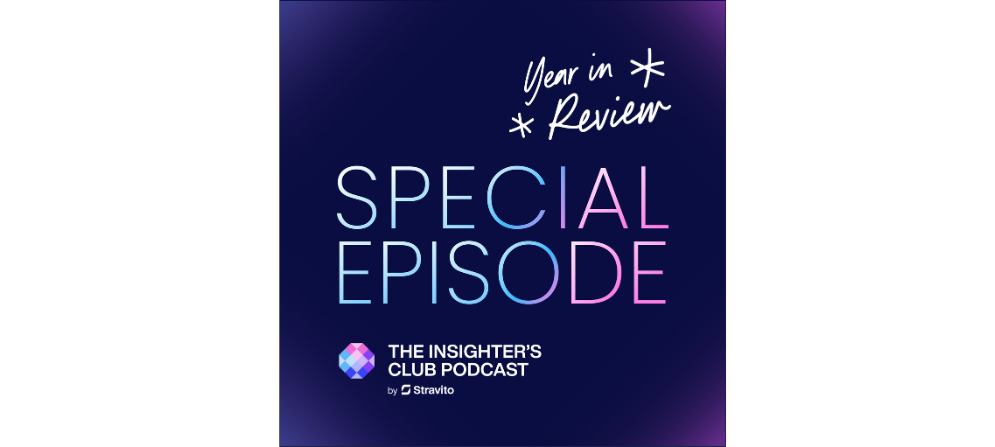
2025 Year In Review
In this special end-of-year episode of the Insighter's Club Podcast, Ross is joined by Stravito Founder & CEO Thor Olof Philogène.
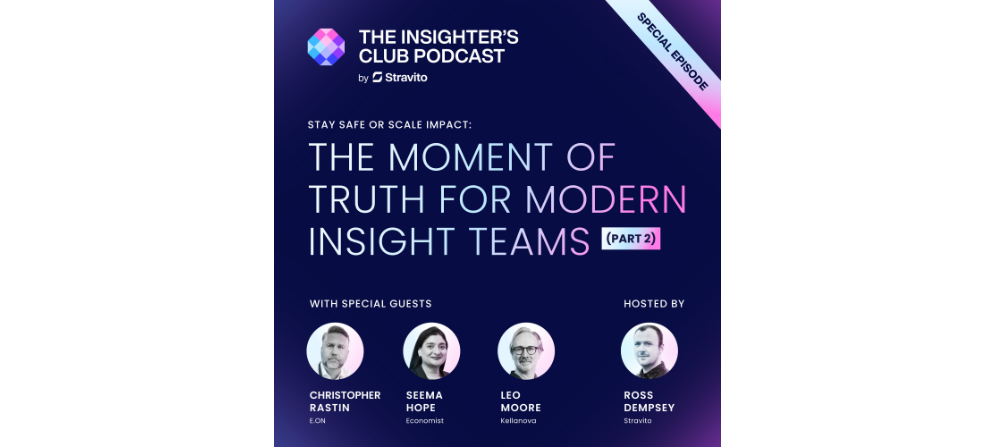
Stay Safe or Scale Impact: The Moment of Truth for Modern Insights Teams (Part 2)
In this special episode of the Insighter's Club Podcast recorded live at the Stravito Customer Summit in Paris, Ross is joined by Seema Hope (VP of...
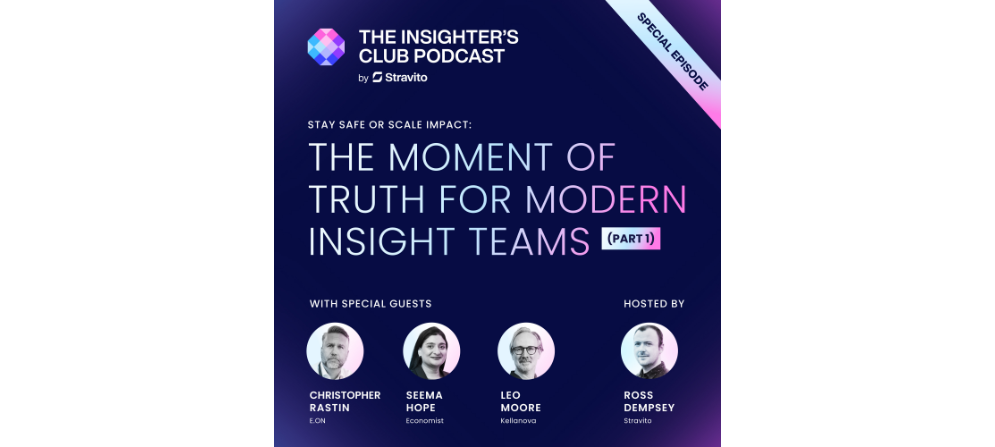
Stay Safe or Scale Impact: The Moment of Truth for Modern Insights Teams
In this special episode of the Insighter's Club Podcast recorded live at the Stravito Customer Summit in Paris, Ross is joined by Seema Hope (VP of...
Subscribe to the latest podcast updates
